The Cambridge History of Japan, Vol. 3: Medieval Japan
Подождите немного. Документ загружается.

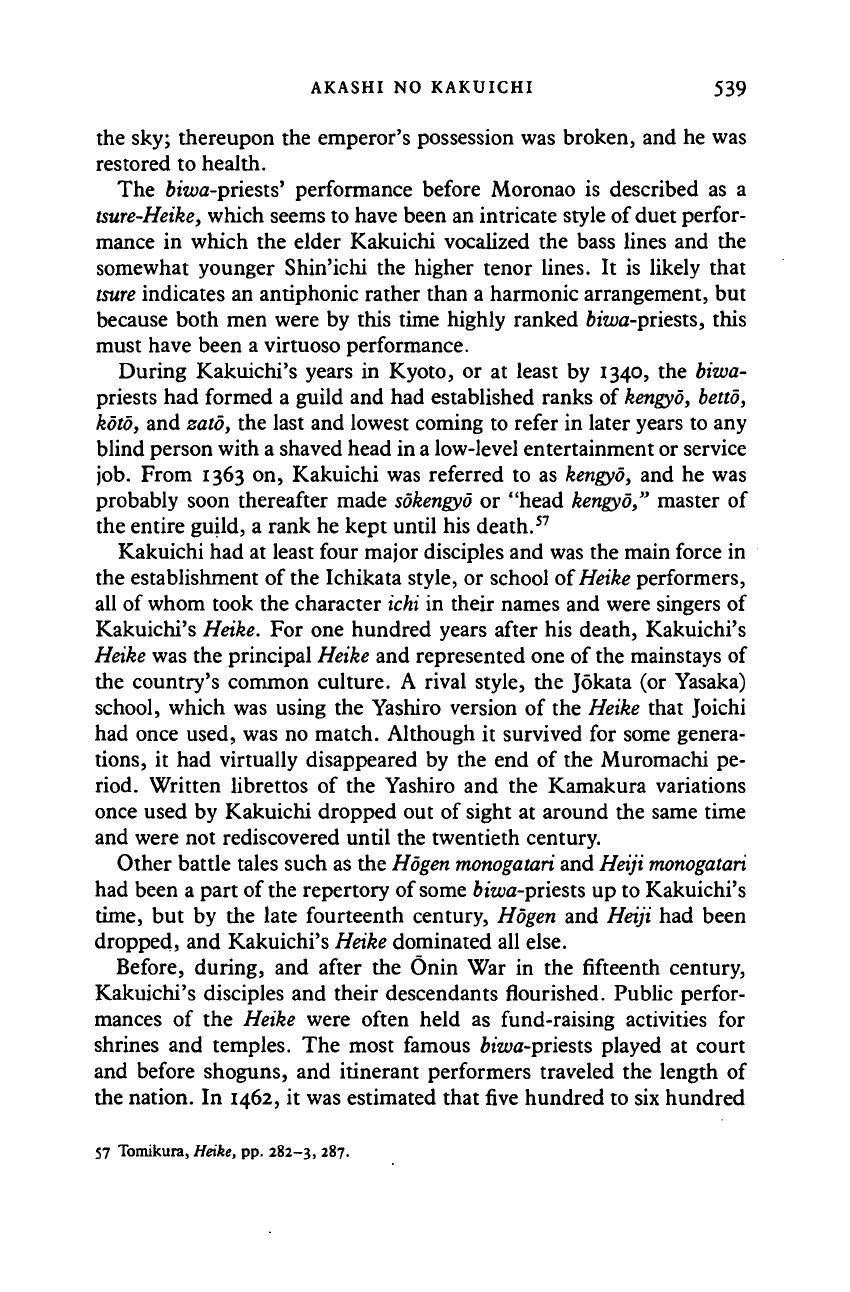
AKASHI NO KAKUICHI 539
the sky; thereupon the emperor's possession was broken, and he was
restored to health.
The biwa-priests' performance before Moronao is described as a
tsure-Heike, which seems to have been an intricate style of duet perfor-
mance in which the elder Kakuichi vocalized the bass lines and the
somewhat younger Shin'ichi the higher tenor lines. It is likely that
tsure
indicates an antiphonic rather than a harmonic arrangement, but
because both men were by this time highly ranked fcm>a-priests, this
must have been a virtuoso performance.
During Kakuichi's years in Kyoto, or at least by 1340, the biwa-
priests had formed a guild and had established ranks of
kengyo,
betto,
koto,
and zato, the last and lowest coming to refer in later years to any
blind person with a shaved head in a low-level entertainment or service
job.
From 1363 on, Kakuichi was referred to as kengyo, and he was
probably soon thereafter made sokengyo or "head kengyo," master of
the entire guild, a rank he kept until his death.
57
Kakuichi had at least four major disciples and was the main force in
the establishment of the Ichikata style, or school of Heike performers,
all of whom took the character ichi in their names and were singers of
Kakuichi's Heike. For one hundred years after his death, Kakuichi's
Heike was the principal Heike and represented one of the mainstays of
the country's common culture. A rival style, the Jokata (or Yasaka)
school, which was using the Yashiro version of the Heike that Joichi
had once used, was no match. Although it survived for some genera-
tions,
it had virtually disappeared by the end of the Muromachi pe-
riod. Written librettos of the Yashiro and the Kamakura variations
once used by Kakuichi dropped out of sight at around the same time
and were not rediscovered until the twentieth century.
Other battle tales such as the Hbgen
monogatari
and Heiji
monogatari
had been a part of the repertory of some 6m>a-priests up to Kakuichi's
time,
but by the late fourteenth century, Hogen and Heiji had been
dropped, and Kakuichi's Heike dominated all else.
Before, during, and after the Onin War in the fifteenth century,
Kakuichi's disciples and their descendants flourished. Public perfor-
mances of the Heike were often held as fund-raising activities for
shrines and temples. The most famous biwa-priests played at court
and before shoguns, and itinerant performers traveled the length of
the nation. In 1462, it was estimated that five hundred to six hundred
57 Tomikura, Heike, pp. 282-3, 287.
Cambridge Histories Online © Cambridge University Press, 2008
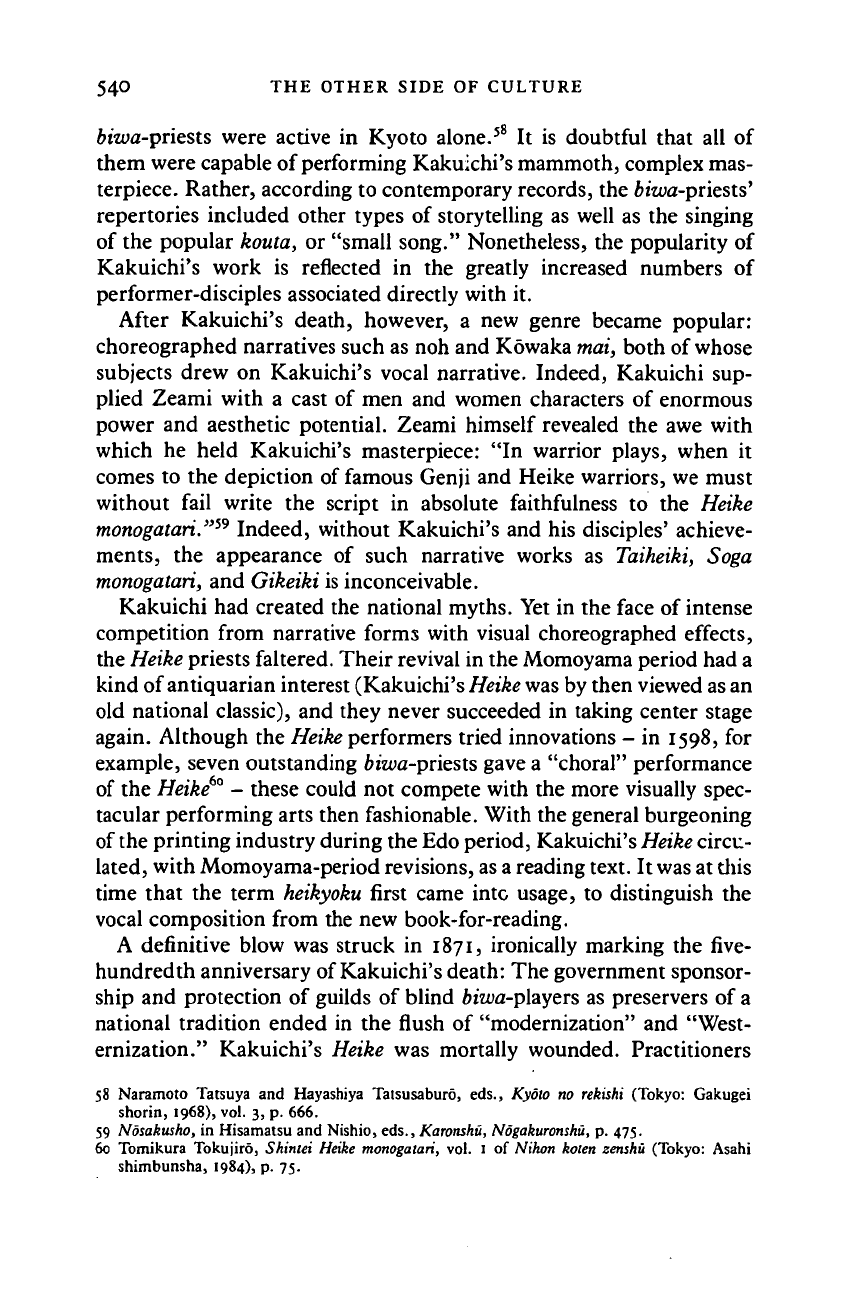
54O THE OTHER SIDE OF CULTURE
biwa-priests were active in Kyoto alone.
58
It is doubtful that all of
them were capable of performing Kakuichi's mammoth, complex mas-
terpiece. Rather, according to contemporary records, the biwa-pncsts'
repertories included other types of storytelling as well as the singing
of the popular kouta, or "small song." Nonetheless, the popularity of
Kakuichi's work is reflected in the greatly increased numbers of
performer-disciples associated directly with it.
After Kakuichi's death, however, a new genre became popular:
choreographed narratives such as noh and Kowaka
max,
both of whose
subjects drew on Kakuichi's vocal narrative. Indeed, Kakuichi sup-
plied Zeami with a cast of men and women characters of enormous
power and aesthetic potential. Zeami himself revealed the awe with
which he held Kakuichi's masterpiece: "In warrior plays, when it
comes to the depiction of famous Genji and Heike warriors, we must
without fail write the script in absolute faithfulness to the Heike
monogatari."
59
Indeed, without Kakuichi's and his disciples' achieve-
ments, the appearance of such narrative works as Taiheiki, Soga
monogatari,
and Gikeiki is inconceivable.
Kakuichi had created the national myths. Yet in the face of intense
competition from narrative forms with visual choreographed effects,
the
Heike
priests faltered. Their revival in the Momoyama period had a
kind of antiquarian interest (Kakuichi's
Heike was
by then viewed
as
an
old national classic), and they never succeeded in taking center stage
again. Although the
Heike
performers tried innovations - in 1598, for
example, seven outstanding
fcm>a-priests
gave a "choral" performance
of the
Heike
60
- these could not compete with the more visually spec-
tacular performing arts then fashionable. With the general burgeoning
of
the
printing industry during the Edo period, Kakuichi's
Heike
circu-
lated, with Momoyama-period revisions,
as a
reading text. It
was
at this
time that the term
heikyoku
first came into usage, to distinguish the
vocal composition from the new book-for-reading.
A definitive blow was struck in 1871, ironically marking the five-
hundredth anniversary of Kakuichi's death: The government sponsor-
ship and protection of guilds of blind
biwa-players
as preservers of a
national tradition ended in the flush of "modernization" and "West-
ernization." Kakuichi's Heike was mortally wounded. Practitioners
58 Naramoto Tatsuya and Hayashiya Tatsusaburo, eds., Kyoto no rekishi (Tokyo: Gakugei
shorin, 1968), vol. 3, p. 666.
59 Nosakusho, in Hisamatsu and Nishio, eds., Karonshu, Nogakuronshu, p. 475.
60 Tomikura Tokujiro, Shintei Heike monogatari, vol. 1 of Nikon koten zenshu (Tokyo: Asahi
shimbunsha, 1984), p. 75.
Cambridge Histories Online © Cambridge University Press, 2008
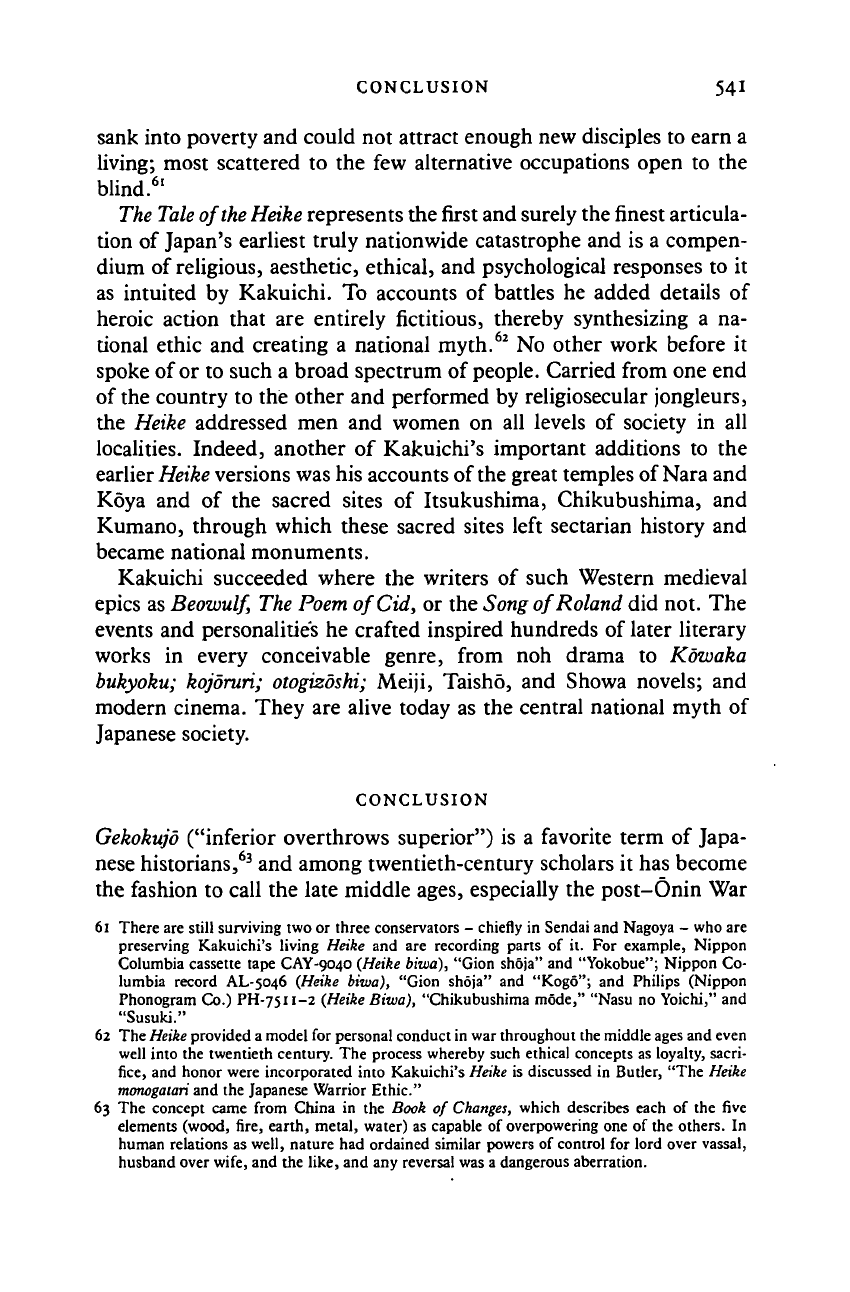
CONCLUSION 541
sank into poverty and could not attract enough new disciples to earn a
living; most scattered to the few alternative occupations open to the
blind.
61
The
Tale
of
the
Heike represents the first and surely the finest articula-
tion of Japan's earliest truly nationwide catastrophe and is a compen-
dium of religious, aesthetic, ethical, and psychological responses to it
as intuited by Kakuichi. To accounts of battles he added details of
heroic action that are entirely fictitious, thereby synthesizing a na-
tional ethic and creating a national myth.
62
No other work before it
spoke of or to such a broad spectrum of people. Carried from one end
of the country to the other and performed by religiosecular jongleurs,
the Heike addressed men and women on all levels of society in all
localities. Indeed, another of Kakuichi's important additions to the
earlier Heike versions was his accounts of the great temples of Nara and
Koya and of the sacred sites of Itsukushima, Chikubushima, and
Kumano, through which these sacred sites left sectarian history and
became national monuments.
Kakuichi succeeded where the writers of such Western medieval
epics as
Beowulf,
The Poem
ofCid,
or the Song of Roland did not. The
events and personalities he crafted inspired hundreds of later literary
works in every conceivable genre, from noh drama to Kowaka
bukyoku; kojoruri; otogizoshi; Meiji, Taisho, and Showa novels; and
modern cinema. They are alive today as the central national myth of
Japanese society.
CONCLUSION
Gekokujo ("inferior overthrows superior") is a favorite term of Japa-
nese historians,
63
and among twentieth-century scholars it has become
the fashion to call the late middle ages, especially the post-Onin War
61 There are still surviving two or three conservators - chiefly in Sendai and Nagoya - who are
preserving Kakuichi's living Heike and are recording parts of it. For example, Nippon
Columbia cassette tape CAY-9040 {Heike biwd), "Gion shoja" and "Yokobue"; Nippon Co-
lumbia record AL-5046 {Heike biwa), "Gion shoja" and "Kogo"; and Philips (Nippon
Phonogram Co.) PH-7511-2 {Heike Biwa), "Chikubushima mode," "Nasu no Yoichi," and
"Susuki."
62 The Heike provided a model for personal conduct in war throughout the middle ages and even
well into the twentieth century. The process whereby such ethical concepts as loyalty, sacri-
fice, and honor were incorporated into Kakuichi's Heike is discussed in Butler, "The Heike
monogatari
and the Japanese Warrior Ethic."
63 The concept came from China in the Book of Changes, which describes each of the five
elements (wood, fire, earth, metal, water) as capable of overpowering one of the others. In
human relations as well, nature had ordained similar powers of control for lord over vassal,
husband over wife, and the like, and any reversal was a dangerous aberration.
Cambridge Histories Online © Cambridge University Press, 2008
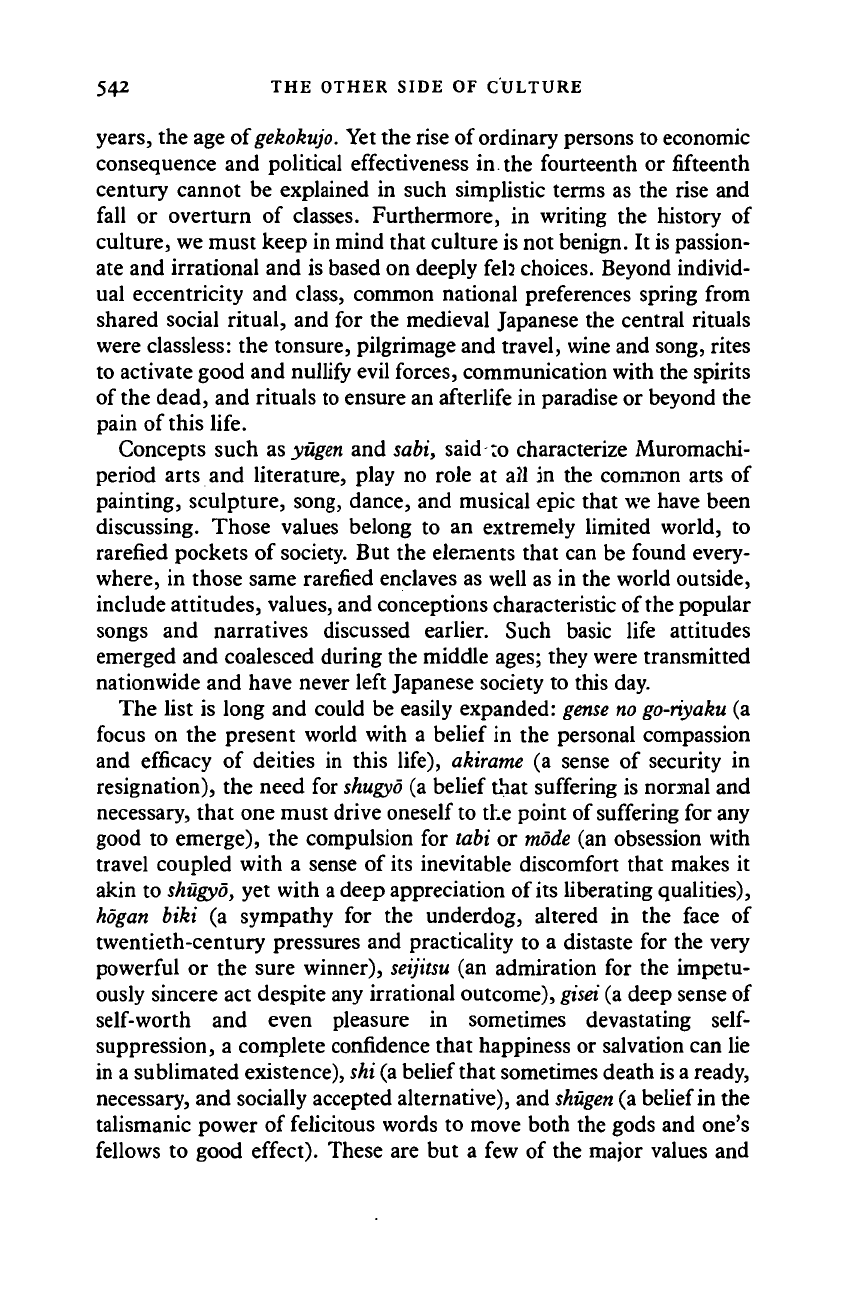
542 THE OTHER SIDE OF CULTURE
years,
the age of
gekokujo.
Yet the rise of ordinary persons to economic
consequence and political effectiveness in the fourteenth or fifteenth
century cannot be explained in such simplistic terms as the rise and
fall or overturn of classes. Furthermore, in writing the history of
culture, we must keep in mind that culture is not benign. It is passion-
ate and irrational and is based on deeply feh choices. Beyond individ-
ual eccentricity and class, common national preferences spring from
shared social ritual, and for the medieval Japanese the central rituals
were classless: the tonsure, pilgrimage and travel, wine and song, rites
to activate good and nullify evil forces, communication with the spirits
of the dead, and rituals to ensure an afterlife in paradise or beyond the
pain of this life.
Concepts such
as yugen
and sabi, said to characterize Muromachi-
period arts and literature, play no role at a?l in the common arts of
painting, sculpture, song, dance, and musical epic that we have been
discussing. Those values belong to an extremely limited world, to
rarefied pockets of society. But the elements that can be found every-
where, in those same rarefied enclaves as well as in the world outside,
include attitudes, values, and conceptions characteristic of
the
popular
songs and narratives discussed earlier. Such basic life attitudes
emerged and coalesced during the middle ages; they were transmitted
nationwide and have never left Japanese society to this day.
The list is long and could be easily expanded:
gense no go-riyaku
(a
focus on the present world with a belief in the personal compassion
and efficacy of deities in this life), akirame (a sense of security in
resignation), the need for
shugyo
(a belief that suffering is normal and
necessary, that one must drive oneself
to
the point of suffering for any
good to emerge), the compulsion for tabi or
mode
(an obsession with
travel coupled with a sense of its inevitable discomfort that makes it
akin to
shugyo,
yet with
a
deep appreciation of
its
liberating qualities),
hogan biki (a sympathy for the underdog, altered in the face of
twentieth-century pressures and practicality to a distaste for the very
powerful or the sure winner),
seijitsu
(an admiration for the impetu-
ously sincere act despite any irrational outcome),
gisei
(a deep sense of
self-worth and even pleasure in sometimes devastating
self-
suppression, a complete confidence that happiness or salvation can lie
in a sublimated existence),
shi
(a belief that sometimes death is
a
ready,
necessary, and socially accepted alternative), and
shugen
(a belief in the
talismanic power of felicitous words to move both the gods and one's
fellows to good effect). These are but a few of the major values and
Cambridge Histories Online © Cambridge University Press, 2008
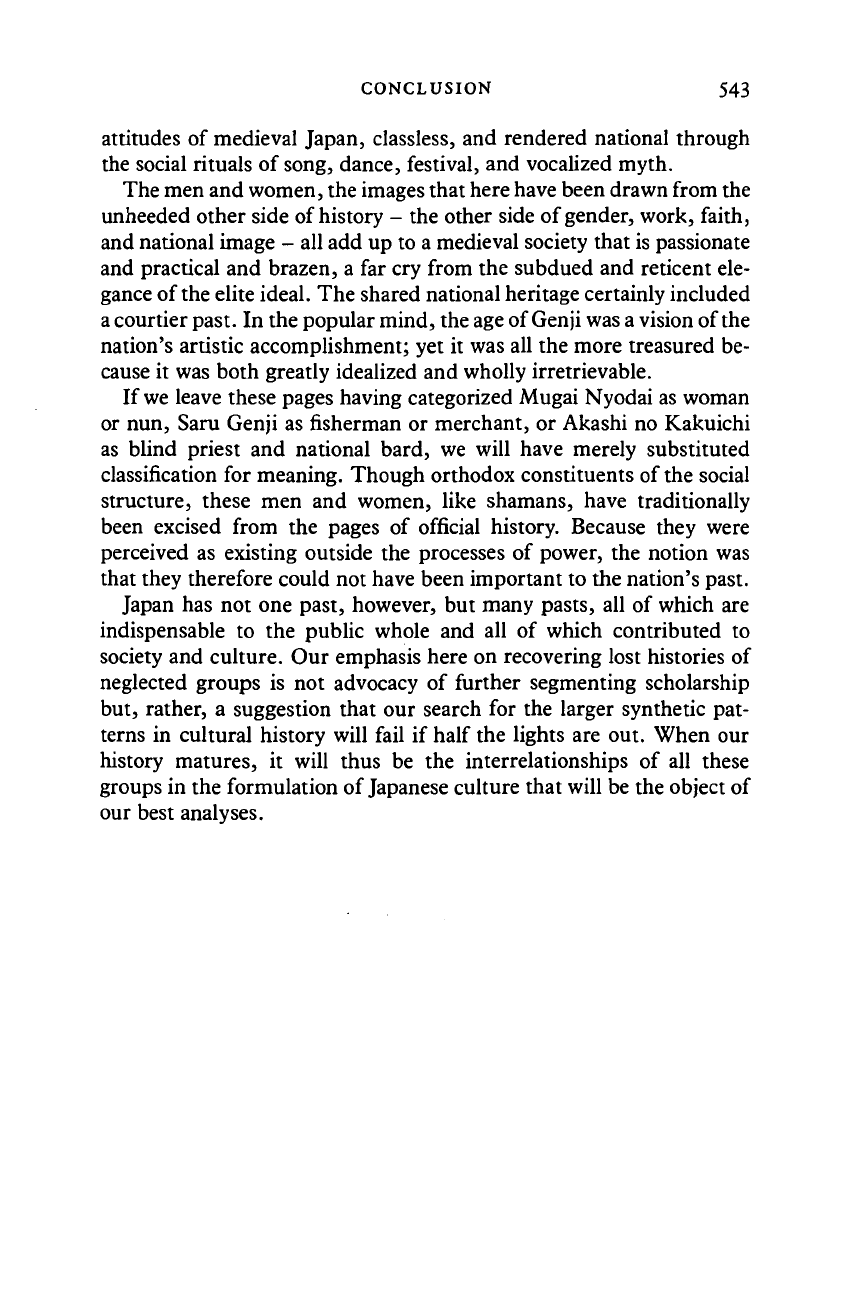
CONCLUSION 543
attitudes of medieval Japan, classless, and rendered national through
the social rituals of song, dance, festival, and vocalized myth.
The men and women, the images that here have been drawn from the
unheeded other side of history - the other side of gender, work, faith,
and national image - all add up to a medieval society that is passionate
and practical and brazen, a far cry from the subdued and reticent ele-
gance of the elite ideal. The shared national heritage certainly included
a
courtier past. In the popular mind, the
age
of Genji was
a
vision of the
nation's artistic accomplishment; yet it was all the more treasured be-
cause it was both greatly idealized and wholly irretrievable.
If
we
leave these pages having categorized Mugai Nyodai as woman
or nun, Saru Genji as fisherman or merchant, or Akashi no Kakuichi
as blind priest and national bard, we will have merely substituted
classification for meaning. Though orthodox constituents of the social
structure, these men and women, like shamans, have traditionally
been excised from the pages of official history. Because they were
perceived as existing outside the processes of power, the notion was
that they therefore could not have been important to the nation's past.
Japan has not one past, however, but many pasts, all of which are
indispensable to the public whole and all of which contributed to
society and culture. Our emphasis here on recovering lost histories of
neglected groups is not advocacy of further segmenting scholarship
but, rather, a suggestion that our search for the larger synthetic pat-
terns in cultural history will fail if half the lights are out. When our
history matures, it will thus be the interrelationships of all these
groups in the formulation of Japanese culture that will be the object of
our best analyses.
Cambridge Histories Online © Cambridge University Press, 2008
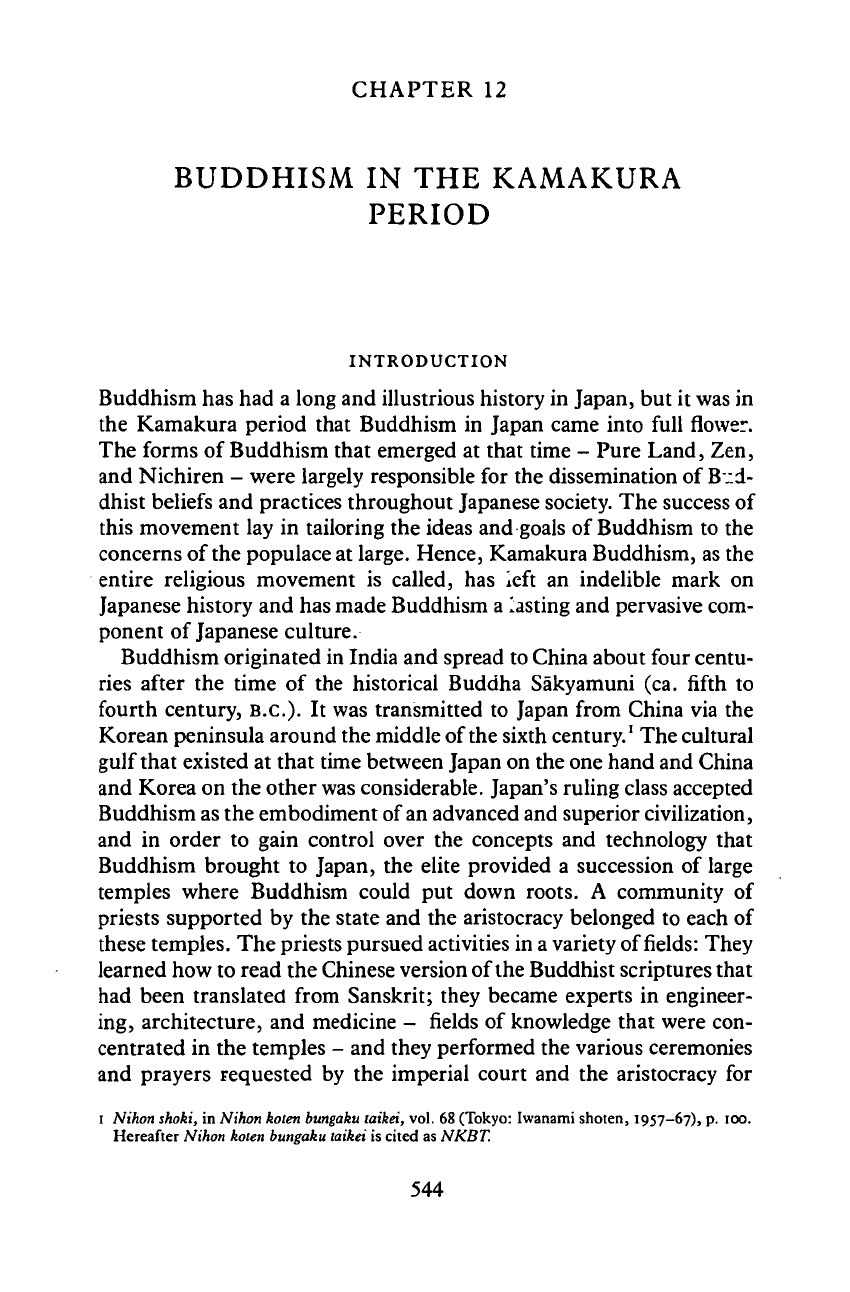
CHAPTER 12
BUDDHISM IN THE KAMAKURA
PERIOD
INTRODUCTION
Buddhism has had a long and illustrious history in Japan, but it was in
the Kamakura period that Buddhism in Japan came into full flower.
The forms of Buddhism that emerged at that time - Pure Land, Zen,
and Nichiren - were largely responsible for the dissemination of Bud-
dhist beliefs and practices throughout Japanese society. The success of
this movement lay in tailoring the ideas and goals of Buddhism to the
concerns of
the
populace at large. Hence, Kamakura Buddhism, as the
entire religious movement is called, has left an indelible mark on
Japanese history and has made Buddhism a lasting and pervasive com-
ponent of Japanese culture.
Buddhism originated in India and spread to China about four centu-
ries after the time of the historical Buddha Sakyamuni (ca. fifth to
fourth century, B.C.). It was transmitted to Japan from China via the
Korean peninsula around the middle of the sixth century.
1
The cultural
gulf that existed at that time between Japan on the one hand and China
and Korea on the other was considerable. Japan's ruling class accepted
Buddhism as the embodiment of an advanced and superior civilization,
and in order to gain control over the concepts and technology that
Buddhism brought to Japan, the elite provided a succession of large
temples where Buddhism could put down roots. A community of
priests supported by the state and the aristocracy belonged to each of
these temples. The priests pursued activities in
a
variety of
fields:
They
learned how to read the Chinese version of the Buddhist scriptures that
had been translated from Sanskrit; they became experts in engineer-
ing, architecture, and medicine - fields of knowledge that were con-
centrated in the temples - and they performed the various ceremonies
and prayers requested by the imperial court and the aristocracy for
i Nikon shoki, in Nihon koten bungaku taikei, vol. 68 (Tokyo: Iwanami shoten, 1957-67), p. 100.
Hereafter Nihon koten bungaku taikei is cited as
NKBT.
544
Cambridge Histories Online © Cambridge University Press, 2008
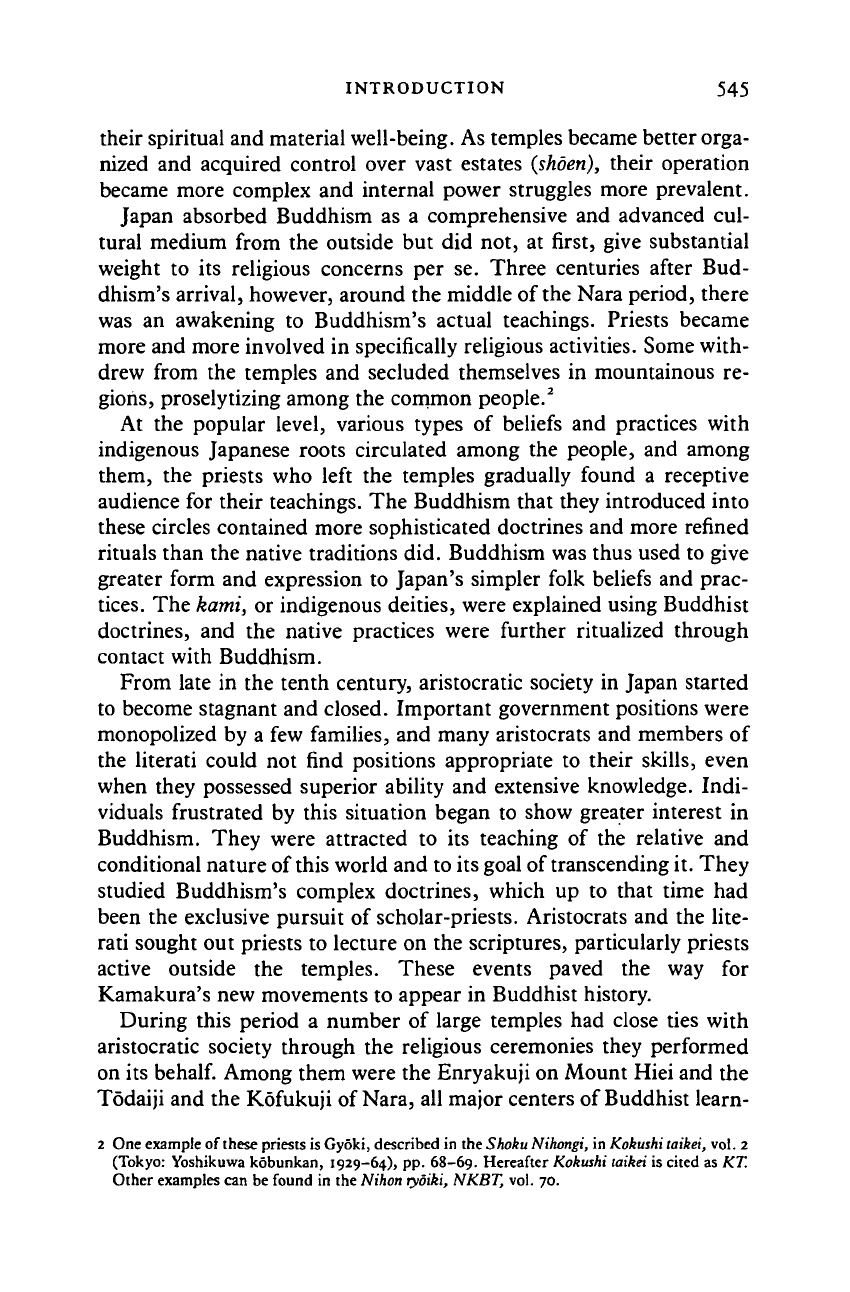
INTRODUCTION 545
their spiritual and material well-being. As temples became better orga-
nized and acquired control over vast estates
(shoen),
their operation
became more complex and internal power struggles more prevalent.
Japan absorbed Buddhism as a comprehensive and advanced cul-
tural medium from the outside but did not, at first, give substantial
weight to its religious concerns per se. Three centuries after Bud-
dhism's arrival, however, around the middle of the Nara period, there
was an awakening to Buddhism's actual teachings. Priests became
more and more involved in specifically religious activities. Some with-
drew from the temples and secluded themselves in mountainous re-
gions,
proselytizing among the common people.
2
At the popular level, various types of beliefs and practices with
indigenous Japanese roots circulated among the people, and among
them, the priests who left the temples gradually found a receptive
audience for their teachings. The Buddhism that they introduced into
these circles contained more sophisticated doctrines and more refined
rituals than the native traditions did. Buddhism was thus used to give
greater form and expression to Japan's simpler folk beliefs and prac-
tices.
The
kami,
or indigenous deities, were explained using Buddhist
doctrines, and the native practices were further ritualized through
contact with Buddhism.
From late in the tenth century, aristocratic society in Japan started
to become stagnant and closed. Important government positions were
monopolized by a few families, and many aristocrats and members of
the literati could not find positions appropriate to their skills, even
when they possessed superior ability and extensive knowledge. Indi-
viduals frustrated by this situation began to show greater interest in
Buddhism. They were attracted to its teaching of the relative and
conditional nature of
this
world and to its goal of transcending it. They
studied Buddhism's complex doctrines, which up to that time had
been the exclusive pursuit of scholar-priests. Aristocrats and the lite-
rati sought out priests to lecture on the scriptures, particularly priests
active outside the temples. These events paved the way for
Kamakura's new movements to appear in Buddhist history.
During this period a number of large temples had close ties with
aristocratic society through the religious ceremonies they performed
on its
behalf.
Among them were the Enryakuji on Mount Hiei and the
Todaiji and the Kofukuji of
Nara,
all major centers of Buddhist learn-
2 One example of these priests is Gyoki, described in the Shoku Nihongi, in Kokushi taikei, vol. 2
(Tokyo: Yoshikuwa kobunkan, 1929-64), pp. 68-69. Hereafter Kokushi laikei is cited as KT.
Other examples can be found in the Nihon ryoiki,
NKBT,
vol. 70.
Cambridge Histories Online © Cambridge University Press, 2008
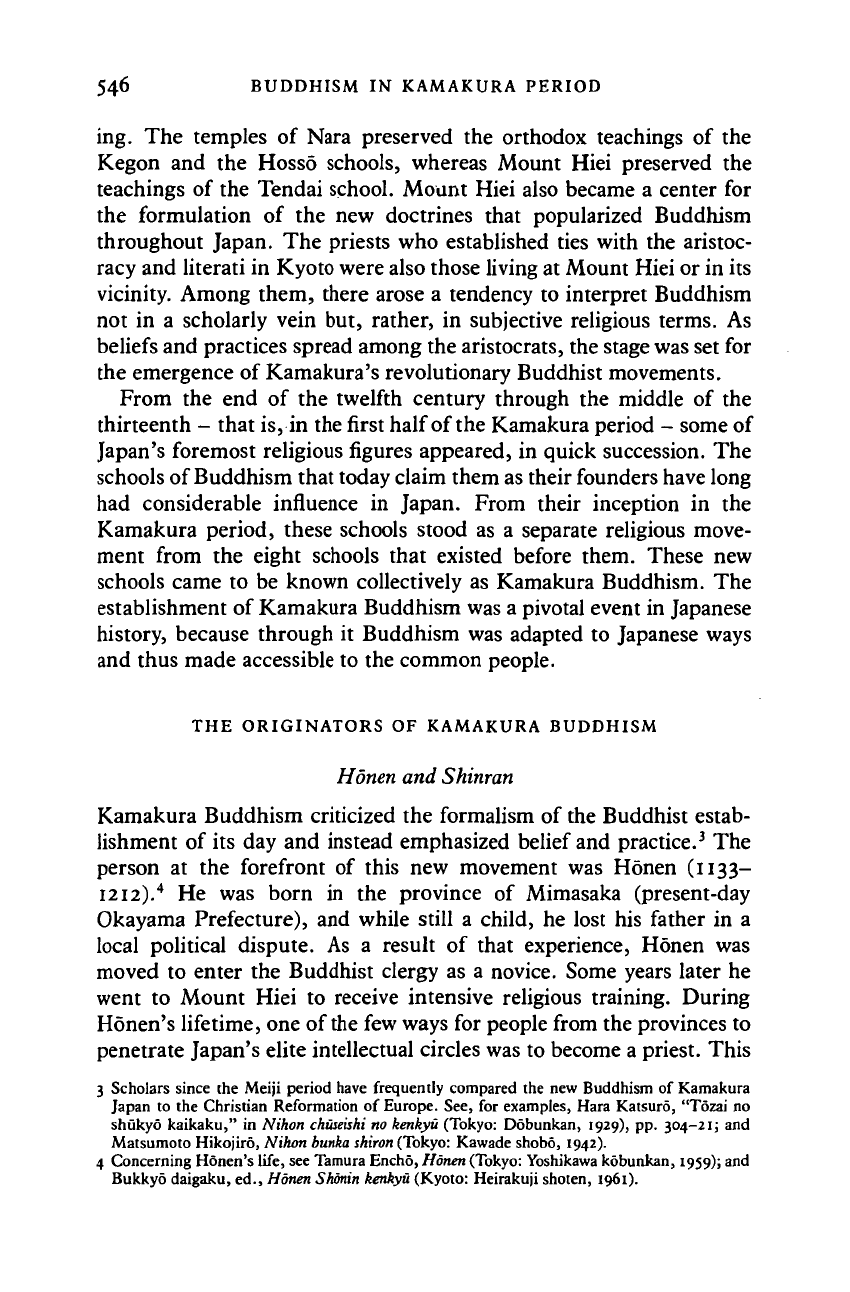
546 BUDDHISM IN KAMAKURA PERIOD
ing. The temples of Nara preserved the orthodox teachings of the
Kegon and the Hosso schools, whereas Mount Hiei preserved the
teachings of the Tendai school. Mount Hiei also became a center for
the formulation of the new doctrines that popularized Buddhism
throughout Japan. The priests who established ties with the aristoc-
racy and literati in Kyoto were also those living at Mount Hiei or in its
vicinity. Among them, there arose a tendency to interpret Buddhism
not in a scholarly vein but, rather, in subjective religious terms. As
beliefs and practices spread among the aristocrats, the stage was set for
the emergence of Kamakura's revolutionary Buddhist movements.
From the end of the twelfth century through the middle of the
thirteenth - that is, in the first half of
the
Kamakura period - some of
Japan's foremost religious figures appeared, in quick succession. The
schools of Buddhism that today claim them as their founders have long
had considerable influence in Japan. From their inception in the
Kamakura period, these schools stood as a separate religious move-
ment from the eight schools that existed before them. These new
schools came to be known collectively as Kamakura Buddhism. The
establishment of Kamakura Buddhism was a pivotal event in Japanese
history, because through it Buddhism was adapted to Japanese ways
and thus made accessible to the common people.
THE ORIGINATORS OF KAMAKURA BUDDHISM
Honen and Shinran
Kamakura Buddhism criticized the formalism of the Buddhist estab-
lishment of its day and instead emphasized belief and practice.
3
The
person at the forefront of this new movement was Honen
(1133-
1212).
4
He was born in the province of Mimasaka (present-day
Okayama Prefecture), and while still a child, he lost his father in a
local political dispute. As a result of that experience, Honen was
moved to enter the Buddhist clergy as a novice. Some years later he
went to Mount Hiei to receive intensive religious training. During
Honen's lifetime, one of
the
few ways for people from the provinces to
penetrate Japan's elite intellectual circles was to become a priest. This
3 Scholars since the Meiji period have frequently compared the new Buddhism of Kamakura
Japan to the Christian Reformation of Europe. See, for examples, Hara Katsuro, "Tozai no
shukyo kaikaku," in Nihon chuseishi no kenkyu (Tokyo: Dobunkan, 1929), pp.
304-21;
and
Matsumoto Hikojiro, Nikon bunka shiron (Tokyo: Kawade shobo, 1942).
4 Concerning Honen's life, see Tamura Encho, Honen (Tokyo: Yoshikawa kobunkan, 1959); and
Bukkyo daigaku, ed., Honen Shonin kenkyu (Kyoto: Heirakuji shoten, 1961).
Cambridge Histories Online © Cambridge University Press, 2008
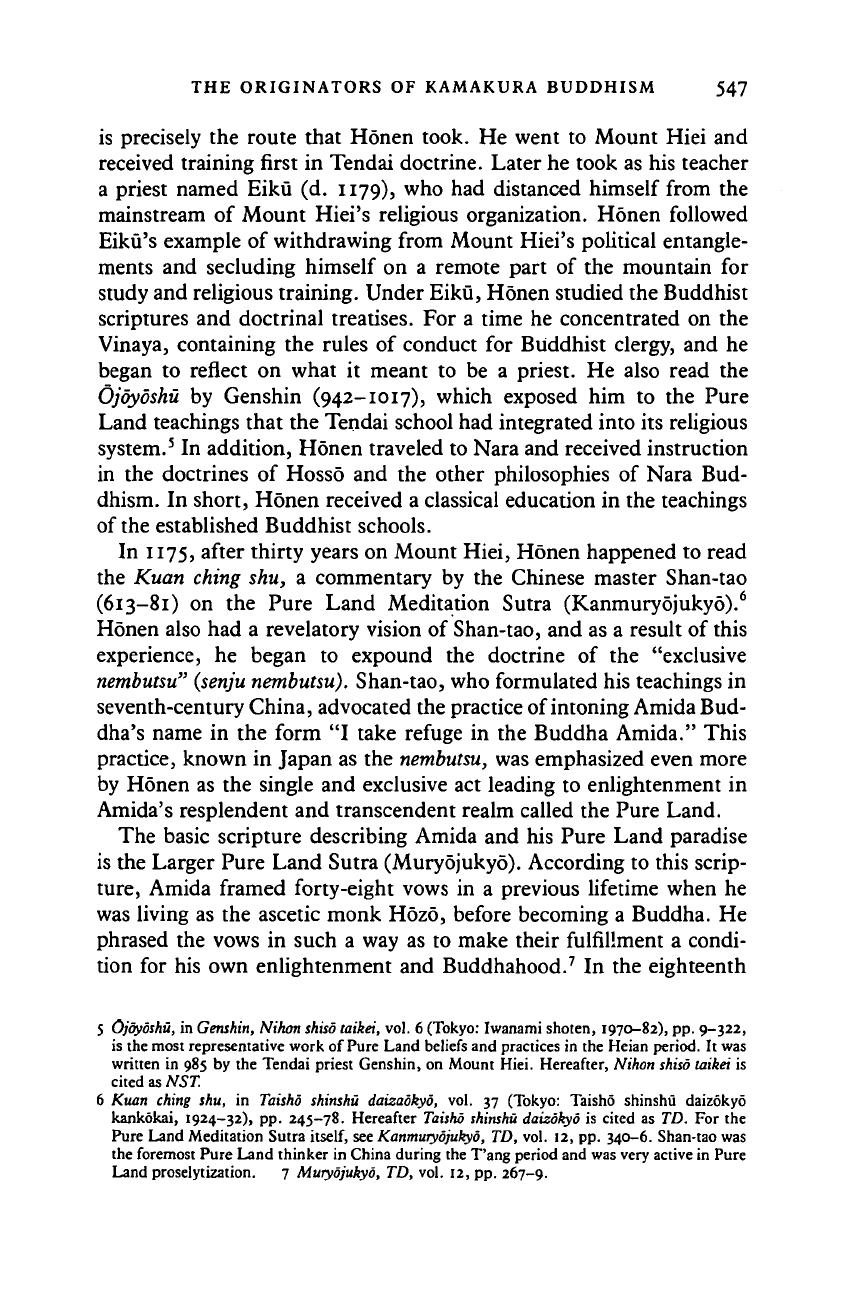
THE ORIGINATORS OF KAMAKURA BUDDHISM 547
is precisely the route that Honen took. He went to Mount Hiei and
received training first in Tendai doctrine. Later he took as his teacher
a priest named Eiku (d. 1179), who had distanced himself from the
mainstream of Mount Hiei's religious organization. Honen followed
Eiku's example of withdrawing from Mount Hiei's political entangle-
ments and secluding himself on a remote part of the mountain for
study and religious training. Under Eiku, Honen studied the Buddhist
scriptures and doctrinal treatises. For a time he concentrated on the
Vinaya, containing the rules of conduct for Buddhist clergy, and he
began to reflect on what it meant to be a priest. He also read the
Ojoyoshu by Genshin (942-1017), which exposed him to the Pure
Land teachings that the Tendai school had integrated into its religious
system.
5
In addition, Honen traveled to Nara and received instruction
in the doctrines of Hosso and the other philosophies of Nara Bud-
dhism. In short, Honen received a classical education in the teachings
of the established Buddhist schools.
In 1175, after thirty years on Mount Hiei, Honen happened to read
the Kuan ching shu, a commentary by the Chinese master Shan-tao
(613-81) on the Pure Land Meditation Sutra (Kanmuryojukyo).
6
Honen also had a revelatory vision of Shan-tao, and as a result of this
experience, he began to expound the doctrine of the "exclusive
nembutsu" (senju nembutsu). Shan-tao, who formulated his teachings in
seventh-century China, advocated the practice of intoning Amida Bud-
dha's name in the form "I take refuge in the Buddha Amida." This
practice, known in Japan as the nembutsu, was emphasized even more
by Honen as the single and exclusive act leading to enlightenment in
Amida's resplendent and transcendent realm called the Pure Land.
The basic scripture describing Amida and his Pure Land paradise
is the Larger Pure Land Sutra (Muryojukyo). According to this scrip-
ture,
Amida framed forty-eight vows in a previous lifetime when he
was living as the ascetic monk Hozo, before becoming a Buddha. He
phrased the vows in such a way as to make their fulfillment a condi-
tion for his own enlightenment and Buddhahood.
7
In the eighteenth
5 Ojoyoshu, in Genshin, Nikon
shiso
taikei, vol. 6 (Tokyo: Iwanami shoten, 1970-82), pp. 9-322,
is the most representative work of Pure Land beliefs and practices in the Heian period. It was
written in 985 by the Tendai priest Genshin, on Mount Hiei. Hereafter, Nihon shiso taikei is
cited as NST.
6 Kuan ching shu, in Taisho shinshu daizaokyo, vol. 37 (Tokyo: Taisho shinshu daizokyo
kankokai, 1924-32), pp. 245-78. Hereafter Taisho shinshu daizokyo is cited as TD. For the
Pure Land Meditation Sutra
itself,
see Kanmuryojukyo, TD, vol. 12, pp. 340-6. Shan-tao was
the foremost Pure Land thinker in China during the T'ang period and was very active in Pure
Land proselytization. 7 Muryojukyo, TD, vol. 12, pp. 267-9.
Cambridge Histories Online © Cambridge University Press, 2008
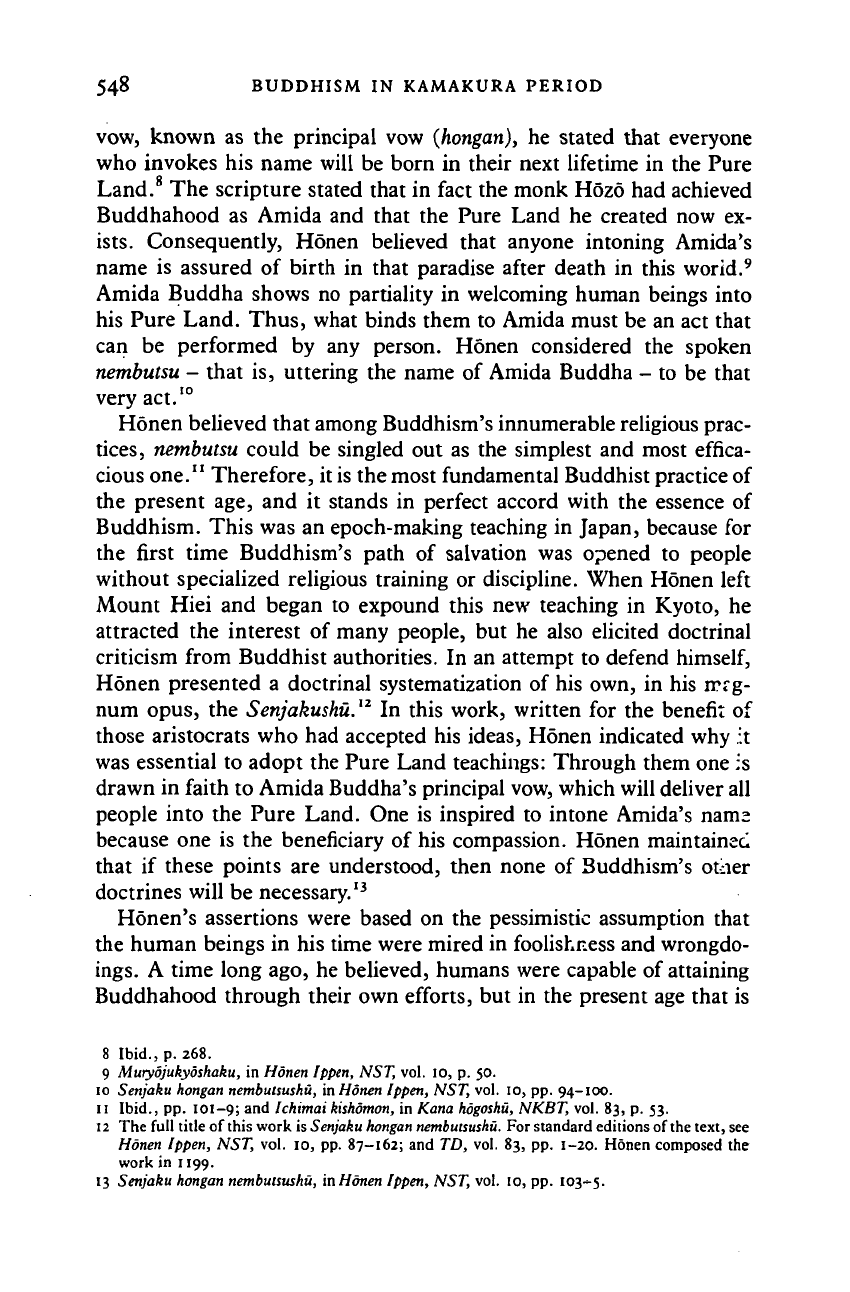
548 BUDDHISM IN KAMAKURA PERIOD
vow, known as the principal vow
(hongan),
he stated that everyone
who invokes his name will be born in their next lifetime in the Pure
Land.
8
The scripture stated that in fact the monk Hozo had achieved
Buddhahood as Amida and that the Pure Land he created now ex-
ists.
Consequently, Honen believed that anyone intoning Amida's
name is assured of birth in that paradise after death in this worid.
9
Amida Buddha shows no partiality in welcoming human beings into
his Pure Land. Thus, what binds them to Amida must be an act that
can be performed by any person. Honen considered the spoken
nembutsu
- that is, uttering the name of Amida Buddha - to be that
very act.
10
Honen believed that among Buddhism's innumerable religious prac-
tices,
nembutsu
could be singled out as the simplest and most effica-
cious one.
11
Therefore, it
is
the most fundamental Buddhist practice of
the present age, and it stands in perfect accord with the essence of
Buddhism. This was an epoch-making teaching in Japan, because for
the first time Buddhism's path of salvation was opened to people
without specialized religious training or discipline. When Honen left
Mount Hiei and began to expound this new teaching in Kyoto, he
attracted the interest of many people, but he also elicited doctrinal
criticism from Buddhist authorities. In an attempt to defend
himself,
Honen presented a doctrinal systematization of his own, in his irrg-
num opus, the Senjakushu.
12
In this work, written for the benefit of
those aristocrats who had accepted his ideas, Honen indicated why it
was essential to adopt the Pure Land teachings: Through them one is
drawn in faith to Amida Buddha's principal vow, which will deliver all
people into the Pure Land. One is inspired to intone Amida's name
because one is the beneficiary of his compassion. Honen maintained
that if these points are understood, then none of Buddhism's other
doctrines will be necessary.
13
Honen's assertions were based on the pessimistic assumption that
the human beings in his time were mired in foolishness and wrongdo-
ings.
A time long ago, he believed, humans were capable of attaining
Buddhahood through their own efforts, but in the present age that is
8 Ibid., p. 268.
9 Muryojukyoshaku, in Honen Ippen, NST, vol. 10, p. 50.
10 Senjaku hongan nembuisushu, in Honen Ippen, NST, vol. io, pp. 94-100.
11 Ibid., pp. 101-9; and Ichimai kishomon, in Kana
hogoshu,
NKBT,
vol. 83, p. 53.
12 The full title of this work is Senjaku
hongan
nembutsushu.
For standard editions of the text, see
Honen Ippen, NST, vol. 10, pp. 87-162; and TD, vol. 83, pp. 1-20. Honen composed the
work in 1199.
13 Senjaku hongan nembutsushu, in Honen Ippen, NST, vol. 10, pp. 103-5.
Cambridge Histories Online © Cambridge University Press, 2008
